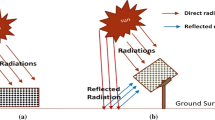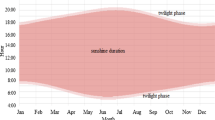Abstract
This paper aims to introduce an approach for multi-hour forecasting (915 h ahead) of hourly global horizontal solar radiation time series and forecasting of a small-scale solar radiation database (30- and 1-s scales) for a period of 1 day (47,000 s ahead) using commonly and available measured meteorological solar radiation. Three methods are considered in this study. First, autoregressive–moving-average (ARMA) model is used to predict future values of the global solar radiation time series. However, because of the non-stationarity of solar radiation time series, a phase of detrending is needed to stationarize the irradiation data; a 6-degree polynomial model is found to be the most stationary one. Secondly, due to the nonlinearity presented in solar radiation time series, a nonlinear autoregressive (NAR) neural network model is used for prediction purposes. Taking into account the advantages of both models, the goodness of ARMA for linear problems and NAR for nonlinear problems, a hybrid method combining ARMA and NAR is introduced to produce better results. The validation process for the site of Ghardaia in Algaria shows that the hybrid model gives a normalized root mean square error (NRMSE) equals to 0.2034 compared to a NRMSE equal to 0.2634 for NAR model and 0.3241 for ARMA model.













Similar content being viewed by others
References
Akaike H (1974) A new look at the statistical model identification. IEEE Trans Autom Control 6:716–723
Al-Sadah FH, Ragab FM, Arshad MK (1990) Hourly solar radiation over Bahrain. Energy 15:395–402
André Luis S, de Maia Francisco AT, de Carvalho Teresa BL (2008) Forecasting models for interval-valued time series. Neurocomputing 71:3344–3352
Badescu V, Gueymard C, Cheval S, Oprea C, Baciu M, Dumitrescu A, Iacobescu F, Milos I, Rada C (2013) Accuracy analysis for fifty-four clear-sky solar radiation models using routine hourly global irradiance measurements in Romania. Renew Energy 55:85–103
Baig A, Achter P, Mufti A (1991) A novel approach to estimate the clear day global radiation. Renew Energy 1:119–123
Bevington PR (1969) Data reduction and error analysis for the physical sciences. McGraw Hill Book Co, New York, p 336
Boata RST, Gravila P (2012) Functional fuzzy approach for forecasting daily global solar irradiation. Atmos Res 112:79–88
Boland JW (2008) Time series and statistical modelling of solar radiation. In: Badescu V (ed) Recent advances in solar radiation modelling. Springer-Verlag, Berlin, pp 283–312
Box GEP, Jenkins G (1970) Time series analysis, forecasting and control. Holden -Day, San Francisco
Chen SX, Gooi HB, Wang MQ (2013) Solar radiation forecast based on fuzzy logic and neural network. Renew Energy 60:195–201
Chow TWS, Leung CT (1996) Non-linear autoregressive integrated neural network model for short term load forecasting. IEE Proc Gener Transm Distrib 143:500–506
Denton JW (1995) How good are neural networks for causal forecasting? J Bus Forecast 14:17–20
Diagne M, David M, Lauret P, Boland J, Schmutz N (2009) Review of solar irradiance forecasting methods and a proposition for small-scale in solar grids. Renew Sust Energ Rev 13:406–419
Dickey DA, Fuller WA (1981) Likelihood ratio statistics for autoregressive time series with a unit root. Econometrica 49:1057–1072
Ginzburg I, Horn D (1994) Combined neural networks for time series analysis. Adv Neural Inf Process Syst 6:224–231
Haykin S (1998) Neural networks: a comprehensive foundation, 2nd edn. Prentice Hall, Upper Saddle River
Huang J, Korolkiewicz M, Agrawal M, Boland J (2013) Forecasting solar radiation on an hourly time scale using a coupled autoregressive and dynamical system (CARDS) model. Sol Energy 87:136–149
Ineichen P (2008) A broadband simplified version of the Solis clear sky model. Sol Energy 82:758–762
Kaplanis S (2006) New methodologies to estimate the hourly global solar radiation; comparisons with existing models. Renew Energy 31:781–790
Kaplanis S, Kaplani E (2007) A model to predict expected mean and stochastic hourly global solar radiation l(h;n j ) values. Renew Energy 32:1414–1425
Khatib T, Mohamed A, Sopian K (2012) A review of solar energy modeling techniques. J Renew Sustain Energy Rev 16:2864–2869
Klipp E, Herwig R, Kowald A, Wierling C, Lehrach H (2008) Systems biology in practice: concepts, implementation and application. John Wiley & Sons, West Sussex, p 327
Kohavi R (1995) A study of cross-validation and bootstrap for accuracy estimation and model selection. Proceedings of the Fourteenth International Joint Conference on Artificial Intelligence 2 (12):1137–1143. Morgan Kaufmann, San Mateo, CA
Kostylev V, Pavlovski A (2011) Solar power forecasting performance—towards industry standards. Proceedings of the 1st International Workshop on the Integration of Solar Power into Power Systems, Aarhus, Denmark
Kugiumtzis D (2000) Surrogate data test for nonlinearity including nonmonotonic transforms. Phys Rev E Stat Phys Plasmas Fluids Relat Interdiscip Topics 62(1):R25–R28
Kwiatkowski D, Phillips PCB, Schmidt P, Shin Y (1992) Testing the null hypothesis of stationarity against the alternative of a unit root. J Econom 54:159–178
Levenberg K (1944) A method for the solution of certain problems in least squares. Q Appl Math 5:164–168
Lewis CD (1982) International and business forecasting methods. Butterworths, London
Ljung L (1998) System identification: theory for the user, 2nd edn. Prentice Hall PTR, Upper Saddle River
Luxhoj JT, Riis JO, Stensballe B (1996) A hybrid econometric-neural network modeling approach for sales forecasting. Int J Prod Econ 43:175–192
MacKay DJC (1992) Bayesian interpolation. Neural Comput 4:415–447
MacQueen JB (1967) Some methods for classification and analysis of multivariate observations. Proceedings of 5th Berkeley Symposium on Mathematical Statistics and Probability 1. University of California Press, Berkeley, pp 281–297
Makridakis S, Wheelwright SC, Hyndman RJ (1998) Forecasting: methods and applications, 3rd edn. John Wiley & Sons, New York
Markham IS, Rakes TR (1998) The effect of sample size and variability of data on the comparative performance of artificial neural networks and regression. Comput Oper Res 25:251–263
Mellit SA, Kalogirou L, Hontoria SS (2009) Artificial intelligence techniques for sizing photovoltaic systems: a review article. Renew Sust Energ Rev 13:406–419
Mellit A, Massi Pavan A, Benghanem M (2013) Least squares support vector machine for short-term prediction of meteorological time series. Theor Appl Climatol 111:297–307
Mihalakakou G, Santamouris M, Asimakopoulos DN (2000) The total solar radiation time series simulation in Athens, using neural networks. Theor Appl Climatol 66:185–197
Moller MF (1993) A scaled conjugate gradient algorithm for fast supervised learning. Neural Netw 4:525–533
Pandey PK, Soupir ML (2012) A new method to estimate average hourly global solar radiation on the horizontal surface. Atmos Res 115:83–90
Peled A, Appelbaum J (2013) Evaluation of solar radiation properties by statistical tools and wavelet analysis. Renew Energy 59:33–38
Pelikan E, de Groot C, Wurtz D (1992) Power consumption in West-Bohemia: improved forecasts with decorrelating connectionist networks. Neural Netw World 2:701–712
Voyant C, Muselli M, Paoli C, Nivet M (2013) Hybrid methodology for hourly global radiation forecasting in Mediterranean area. Renew Energy 53:1–11
Wedding DK, Cios KJ (1996) Time series forecasting by combining RBF networks, certainty factors, and the Box–Jenkins model. Neurocomputing 10:149–168
Wu J, Chan KC (2011) Prediction of hourly solar radiation using a novel hybrid model of ARMA and TDNN. Sol Energy 85:808–817
Zhang G (2003) Time series forecasting using a hybrid ARIMA and neural network model. Neurocomputing 50:159–175
Zhang G, Patuwo EB, Hu MY (1998) Forecasting with artificial neural networks: the state of the art. Int J Forecast 14:35–62
Acknowledgments
The authors would like to thank the University of Laghouat for the financial aspect of the present work. Also, the authors would like to thank Dr. Tamer Khatib and Dr. Hussian Kazem for providing experimental data used for further validation of the proposed model. These data were obtained from an experiment done in the frame of the research project no. ORG SU EI 11 010. Funded by the research council of the Sultanate of Oman.
Author information
Authors and Affiliations
Corresponding author
Rights and permissions
About this article
Cite this article
Benmouiza, K., Cheknane, A. Small-scale solar radiation forecasting using ARMA and nonlinear autoregressive neural network models. Theor Appl Climatol 124, 945–958 (2016). https://doi.org/10.1007/s00704-015-1469-z
Received:
Accepted:
Published:
Issue Date:
DOI: https://doi.org/10.1007/s00704-015-1469-z




